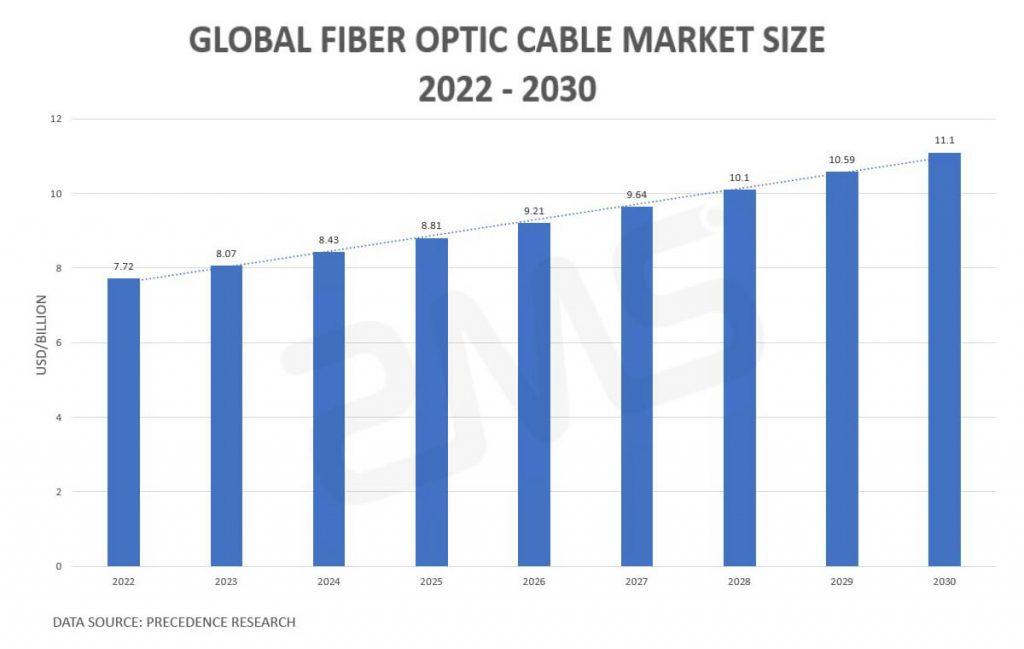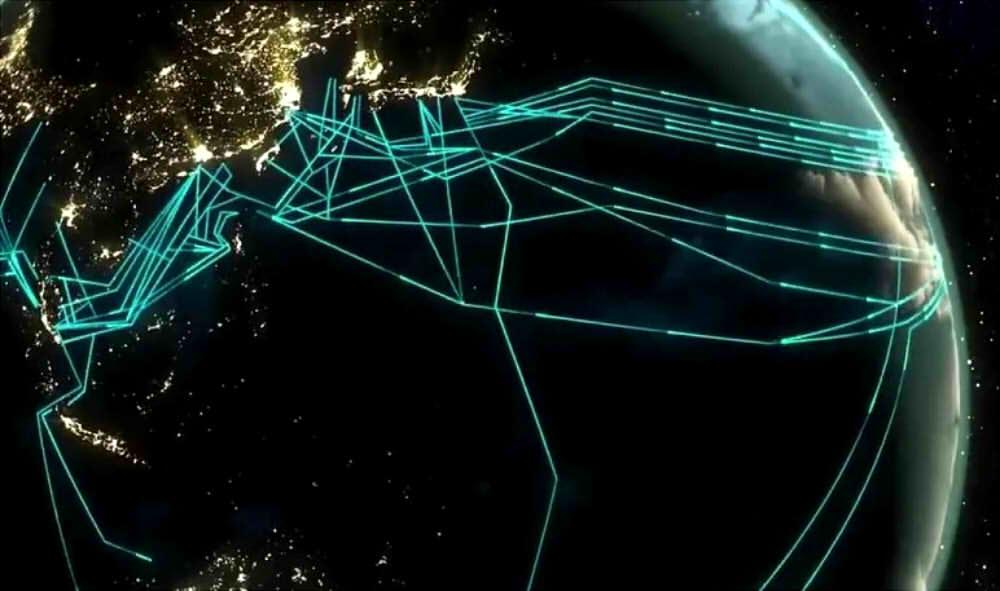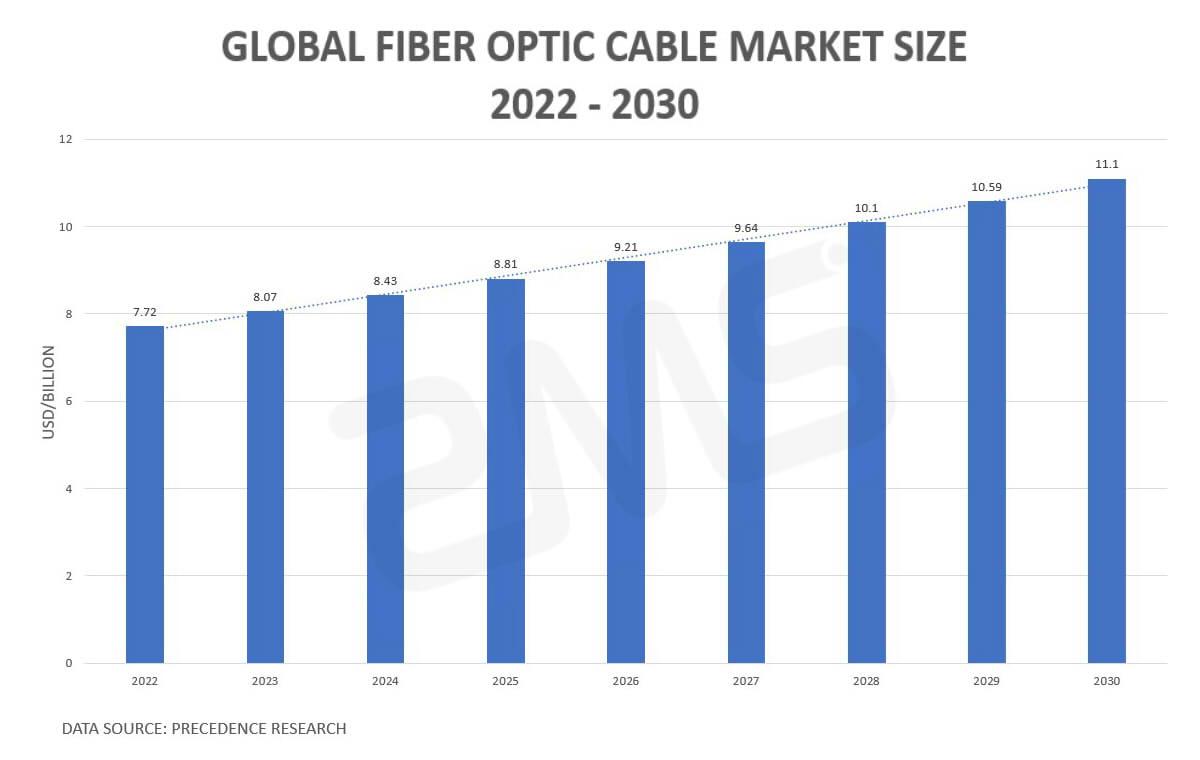Fiber optic cables have the advantages of high transmission capacity, low fade, long transmission distance, light weight and no electromagnetic interference.
Being the most promising communications transmission medium today, It is being widely used for signal transmission in various sectors. Currently, fiber optic cables are gradually becoming the mainstay of communication networks.
With the development of communication technologies in various fields, like the global internet, 5G and IoT, demand for optical cables continues to grow. Currently, the supply of optical fibers worldwide is scarce. And the prices of fiber optic cables have risen a 70% from its record low in March 2021, passing from 3,7 a 6,3 dollars per kilometer.

The global market for fiber optic cables is expected to reach 11.180 million dollars in 2030, with an annual growth rate of 9,3% during the planned period.
Advances in Optical Communications Technology
Future development of optical communication technology revolves around performance improvement and cost savings. One of the trends in fiber optic communication is the evolution of all optical networks. An all-optical network means that the transmission and switching processes of the network are all carried out through optical fibers..
No need for electrical to optical and optical to electrical conversion in the middle of the line, network speed can increase considerably. The data shows that the bandwidth of copper cable access is only 512Kbps, but the bandwidth of the whole broadband optical network can reach from 50 a 100Mbps.
Another trend in fiber optic communications is the flattening of networks. The flattened transmission network will go from a tree-shaped architecture to a flattened architecture. MESH. This will not only reduce the number of devices and save on hardware costs, it will also reduce electricity costs and labor investment.
In addition to the architectural changes, In addition to the architectural changes, network simplification also needs to introduce advanced operation and maintenance technologies. With the introduction of artificial intelligence technology, as well as big data, operators can achieve intelligent operation of the entire transmission network.
when problems arise, AI can give a quick answer, reducing the duration of service interruptions. The introduction of intelligent operation and maintenance not only saves costs, but also has the advantage of energy efficient.
Internet Development Drives Expansion of Fiber Optic Demand
People's demand for high-speed, high-traffic networks is increasing. With applications such as the Internet of Things, cloud computing and mobile communication network construction, the optical cable industry will see more development opportunities.
In the fixed broadband sector, Ethernet fiber optics can currently reach speeds of 10Mbps, 100Mbps and 1Gbps as standard. The introduction of Ethernet standards continues to support higher bit rates and longer transmission distances.. The development of Ethernet technology has laid a solid foundation for the use of fiber optic cables in fixed broadband applications..
In the 5G sector, according to the GSMA, operators around the world will invest a total of 700.000 million dollars in 5G networks between 2021 Y 2025. at the end of 2025 there will be 1.800 million 5G connections worldwide.
5G base stations will use UDN networks to achieve basic coverage. How 5G base stations use medium and high frequency resources, the area covered by a single station will be smaller and the number of base stations will increase compared to 4G. The multiplication of the number of base stations will create a high demand for fiber optic cables for 5G carrier networks.
Subsea Fiber Optic Cables Help Interconnect The World
Submarine fiber optic cables are the most important infrastructure of the digital age. Till the date, a total of 1,2 million kilometers of submarine fiber optic cables, enough to give 30 around the world.

Some 400 fiber optic cables buried deep under the seabed form the backbone of today's international Internet. They carry more than 95% of global internet traffic. Global integration and the rise of the digital economy have inspired a rapid increase in demand for international bandwidth.
In addition to the traditional manufacturers and operators of submarine optical fibers, In recent years, Internet giants such as Microsoft have entered the market., Google and Facebook. This is mainly because the popularity of the Internet has led to an ever-increasing demand for huge amounts of data transmission..
The global market for submarine cables is expected to grow at a CAGR of 11,04% in between 2021 Y 2025. The size is expected to exceed 3.800 million dollars during the period.
FTTx Development Goals Drive Fiber Access
Según Bridge Market Research, the fttx market (fibra a x) will grow at a CAGR of 8,62% during the period 2022-2029. The market could reach 1.340 million in 2029.
North America is expected to dominate the passive optical LAN market due to growing demand for passive optical networks in the region. The Asia-Pacific region will be the one that grows the most, as governments are pushing for more investment in fiber broadband.
European countries are relatively weak in building fiber optic networks, with only one 34% and a 56% users in the UK and France. Deutsche Telekom has announced that it will strive to achieve 10 million homes in 2024 and all the homes in 2030. Spain has implemented the plan “Digital Spain 2025” to boost the penetration of broadband 100 Mbps up to 100%. The Italian government plans to spend 6.700 million euros to expand its broadband network.
According to CRU forecasts, demand is expected to fiber optic lines in emerging markets grow at a CAGR of 5-6% in between 2022 Y 2026. And it is expected that the penetration of FTTH in Latin America, Middle East and Africa reach the 36% in 2026.
Challenges for the Development of Fiber Optic Cables

The price, longevity, capacity and maintenance limit the development of the fiber optic cable industry. Although the potential for fiber optic development is high, the market for fiber optic cables is highly competitive and faces political and technological uncertainties. There are still certain risks in the development process.
At the same time, fiber optic products have a limited lifespan and are difficult to maintain. This is an unavoidable pain point in the development of the industry. Serious overcapacity of optical rods has caused fierce price competition. Although the price of optical fibers has fallen, that of raw materials has continued to rise, which has left fiber optic cable manufacturers in a tough spot for a while.
The development of manufacturing technology, new product development and smart production can help, To some extent, overcome the challenges facing the development of fiber optic cables.
Subscribe to our newsletter!

